In Kenya, like every other country in the world, adequate credit to the private sector plays an important role in economic growth by ensuring that there is efficient allocation of resources for investment. Subsequently, for an economy to function well, there should exist alternative sources to provide private sector credit, and the government through its regulatory and legislative arms should provide an enabling environment for businesses to grow and providers of capital to compete. In Kenya, the main provider of capital to businesses is the Banking sector, estimated to provide 99.0%, while alternative sources provide a combined 1.0%. Private sector credit from the banking sector currently stands at Kshs 3.3 tn, equivalent to approximately 26.1% of the GDP. This continues to lag behind other advanced economies such as USA and Japan where the Private sector credit to GDP ratio stood at 216.0% and 192.8% respectively in 2020. Closer to home, in economies such as Mauritius, the Private sector credit as a percentage of GDP stood at 95.9% in 2020. From the above, it is clear that Kenya has some work to do to bridge the gap in Private sector credit. As such, we saw it fit to cover a topical on the private sector credit growth to shade light on the evolution, current state of lending to the private sector and give our recommendations on what can be done to improve credit access to the private sector. We shall do this by looking into the following:
- Introduction,
- Kenya’s Private sector credit performance,
- Factors influencing Private Sector credit growth,
- Initiatives placed to promote Private sector credit growth,
- Comparison against other countries, and,
- Conclusion and key consideration to improving private sector credit performance in Kenya
Section I: Introduction
Private sector is a section of the economy that is not state-owned comprising of private organizations and individual investors and is largely profit oriented. Private sector credit refers to the financial resources provided to the private sector by financial corporations for the development of the economy. In Kenya, the major constituents of the private sector lending include commercial banks, capital markets, Saccos, microfinance institutions, finance and leasing companies, pension funds, as well as insurance corporations. Despite the Kenya financial sector being dominated by banking institutions which contribute 99.0% of the total lending, private sector credit growth has remained relatively low, averaging at 10.6% for the nine years under review. As such, in comparison to developed economies, capital markets funding in Kenya at 1.0% is underdeveloped whereas the developed economies have bank and capital markets funding at 60.0% and 40.0% respectively. The table below shows the comparison of business funding in Kenya against developed economies;
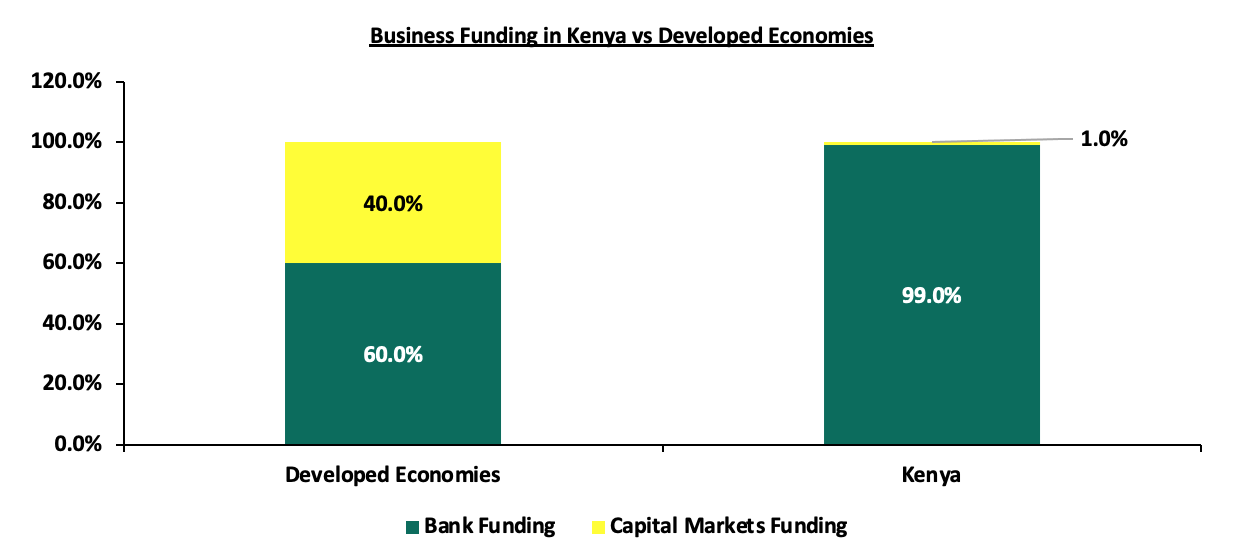
Source: Cytonn Research
In Kenya, the private sector is a significant contributor to economic growth as well as employment creation. The sector comprises of private corporates and small and medium enterprises (SMEs) with the latter accounting for 90.0% of private sector enterprises and employs approximately nine out of ten workers in the country. Accessibility of credit has been a challenge especially to the SMEs, largely attributable to high risk perception by banks, and the high cost of credit charged on the current available credit options.
Section II: Kenya’s Private sector credit performance
- Evolution of Private sector credit
There has been a significant rise in banks’ lending to the private sector over the years, with the total domestic credit extended to the private sector credit increasing at a 7-year CAGR of 6.5% to Kshs 3.1 tn in August 2022, from Kshs 2.1 tn in August 2015, in line with the relative economic growth averaging at 4.8% for the last 7 years. Credit extended to the private sector as at August 2022 stands at Kshs 3.3 tn, with the sector with the highest allocation being credit to the trade sector at Kshs 504.4 bn, equivalent to 15.2% of the total credit. In terms of YTD growth, the mining and quarrying, as well as agriculture grew at 45.6% and 16.8% to Kshs 21.4 bn and Kshs 110.1 bn respectively, from Kshs 10.9 bn and Kshs 92.4 bn respectively in January 2022. The positive credit uptake shows resilience of the two segments despite increased credit risk due to the deteriorated business environment following elevated inflationary pressures. The graph below shows the cumulate private credit over the period under review;
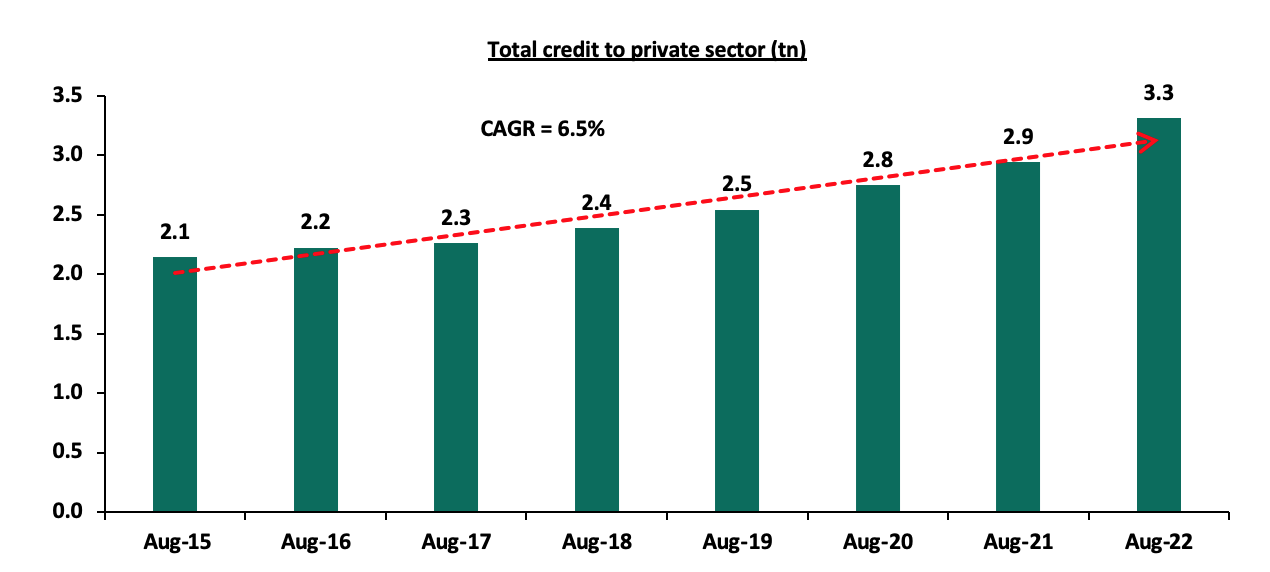
Source: Central Bank of Kenya
Private sector credit growth has been on an upward trajectory in 2022, reaching 12.5% in the 12-months to August 2022 compared to 7.0% in August 2021, attributable to increased credit demand despite elevated credit risk brought about by the electioneering period. Credit growth was mainly driven by sectors such as Agriculture, Business Services and Manufacturing at 19.2%, 16.1%, and 15.2%. Key to note, Finance and Insurance sector as well as the Real Estate Sector had the lowest y/y credit growth rates at 1.2% and 1.0% respectively. According to the Central Bank of Kenya, Real Estate credit uptake was low with gross loans advanced to the Real Estate sector increasing by 4.2% to Kshs 466.8 bn in H1’2022, from Kshs 448.0 bn realized in H1’2021. The slow growth was mainly attributed to the increased credit risk on the sector partly due to slowdown in activity in the build up to the 2022 general elections, coupled with subdued demand for property amid rising construction costs and a 16.4% increase in Non-Performing Loans (NPLs) in the Real Estate sector to Kshs 79.4 bn in H1’2022, from Kshs 68.2 bn in H1’2021. Key to note, the increase in NPLs was driven by tough economic environment as a results of ripple effects of Covid-19, and further fueled The table below shows the sectoral credit uptake on y/y and year to date basis:
|
Cytonn Report: Sectoral Credit Uptake (Kshs bn) |
|||||
|
|
Aug-21 |
Jan-22 |
Aug-22 |
Last 12 Months Change (%) |
YTD change (%) |
|
Mining and quarrying |
10.9 |
14.7 |
21.4 |
96.3% |
45.6% |
|
Other activities |
74.8 |
91.5 |
120.2 |
60.7% |
31.4% |
|
Agriculture |
92.4 |
94.3 |
110.1 |
19.2% |
16.8% |
|
Business services |
163.5 |
174.7 |
189.8 |
16.1% |
8.6% |
|
Manufacturing |
437.8 |
459.9 |
504.4 |
15.2% |
9.7% |
|
Consumer durables |
318.2 |
339.2 |
363 |
14.1% |
7.0% |
|
Transport & communication |
237.9 |
258.8 |
270.1 |
13.5% |
4.4% |
|
Trade |
504.2 |
532.4 |
571.5 |
13.3% |
7.3% |
|
Building and construction |
121 |
125.2 |
134.9 |
11.5% |
7.7% |
|
Private households |
462.7 |
477.7 |
498.8 |
7.8% |
4.4% |
|
Finance & insurance |
109 |
112.2 |
110.3 |
1.2% |
(1.7%) |
|
Real estate |
410.6 |
409.9 |
414.8 |
1.0% |
1.2% |
|
Total credit advanced |
2,943.0 |
3,090.5 |
3,310.1 |
12.5% |
7.1% |
Source: Central Bank of Kenya
The Kenyan private sector credit growth is subdued even after the removal of interest rates cap in November 2019 with average growth rate coming in at 8.7% since the removal compared to the growth rate of 10.6% for the 9-year period. While the capping of interest rates was implemented to control lending rates to the sector, the consequence as highlighted on our note on the impact of capping interest rates on the economy, was a contraction on the supply side of credit as banks had lower profit margins attributable to tougher lending environment. The positive private sector credit uptake in 2021 and 2022 was largely driven by economic recovery following gradual easing of COVID-19 restrictions evidenced by 7.5% GDP expansion in 2021 as well as a 7.3% and 4.4 % year to date expansion in trade and private household consumption, respectively. Despite the expansion in private sector credit uptake, the current growth rate of 12.5% in August 2022 is still below the historical credit growth levels. The chart below shows the movement of the private sector credit growth:
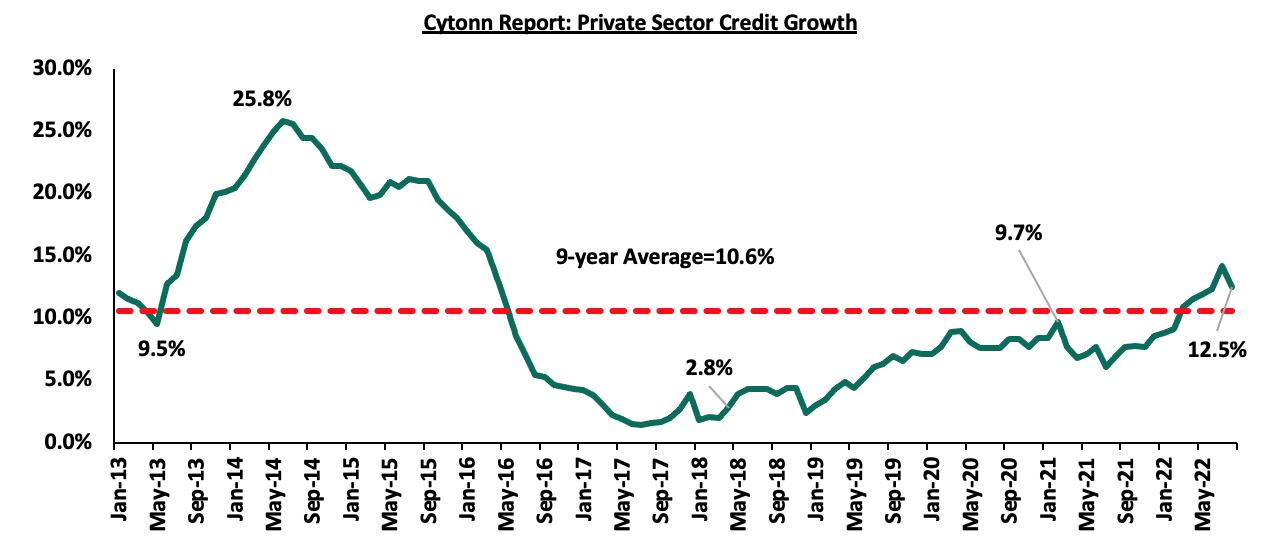
Source: Central Bank of Kenya
Section III: Factors influencing private sector credit growth
Private sector credit uptake is influenced by a number of factors which include;
- Interest rates – Interest rates affect both the demand and supply side of the credit market. For instance, the capping of interest rates in August 2016 led to low credit growth averaging at 3.7% for the capping period (August 2016-November 2019) with banks minimizing credit access due to the small profit margins. Key to note, the credit uptake has been relatively high during the pre- and post-capping periods with the private sector credit growth averaging at 18.3% and 8.7% respectively for the two periods respectively. However, high interest rates stifle the demand side of the credit market by increasing the cost of borrowing. The average lending rate as at June 2022 stood at 12.7%, a 0.5% points increase from 12.2% in May 2022. Key to note, the increase of the Central bank rates by 0.75 bps to 8.25% in September 2022 tightened liquidity within the economy forcing commercial banks to adjust their lending rates upwards to 14.0%, 13.2%, and 12.5% for corporates, personal and small business loans respectively. With the MPC expected to continue increasing interest rates, we expect the lending rates to increase even further,
- Government domestic borrowing - In Kenya, the government uses various debt instruments such as government securities (treasury bills and bonds), advances from commercial banks and overdrafts from the Central Bank of Kenya to borrow from the domestic market. Commercial banks have continued to hold the highest proportion of Government domestic debt, coming at 47.5% as at October 2022. This is mainly attributable to banks preference to lend to the government, which is considered a risk-free investment, effectively crowding out the private sector, which is considered riskier. Though the holding of domestic debt by commercial banks has declined from a high of 55.4% in the last 10 years, this continues to inhibit credit sector credit growth. The table below shows the holders of domestic public debt for the last 10 years;
Cytonn Report: Domestic Public Debt by Holder (Percent)
Nov-13
Nov-14
Nov-15
Nov-16
Nov-17
Nov-18
Nov-19
Nov-20
Nov-21
Nov-22
Banking Institutions
48.6%
52.9%
55.4%
53.4%
55.2%
54.9%
54.2%
54.3%
50.3%
47.1%
Insurance companies
10.3%
10.1%
8.7%
7.2%
6.2%
6.1%
6.5%
6.3%
6.7%
7.4%
Parastatals
3.6%
2.9%
4.6%
5.7%
6.5%
7.4%
6.8%
5.6%
5.4%
6.2%
Pension funds
25.9%
24.8%
25.3%
27.3%
27.7%
27.1%
28.1%
28.8%
31.5%
33.0%
Other investors
11.5%
9.3%
6.0%
6.4%
4.4%
4.5%
4.4%
54.2%
6.1%
6.4%
Source:(CBK)
- High risk perception by lenders which contribute to high risk premiums – Commercial banks charge higher interest premiums on the loans borrowed to cater for future uncertainty risks. Additionally, according to the Central Bank of Kenya (CBK), the tightened macroeconomic environment in 2022 has resulted in increased credit risks as banks record deteriorating asset quality, driven by increase in non-performing loans (NPLs) to gross loans ratio to 14.7% in Q2’2022, up from 14.0% recorded in Q1’2022. The graph below shows the movement for the years under review;
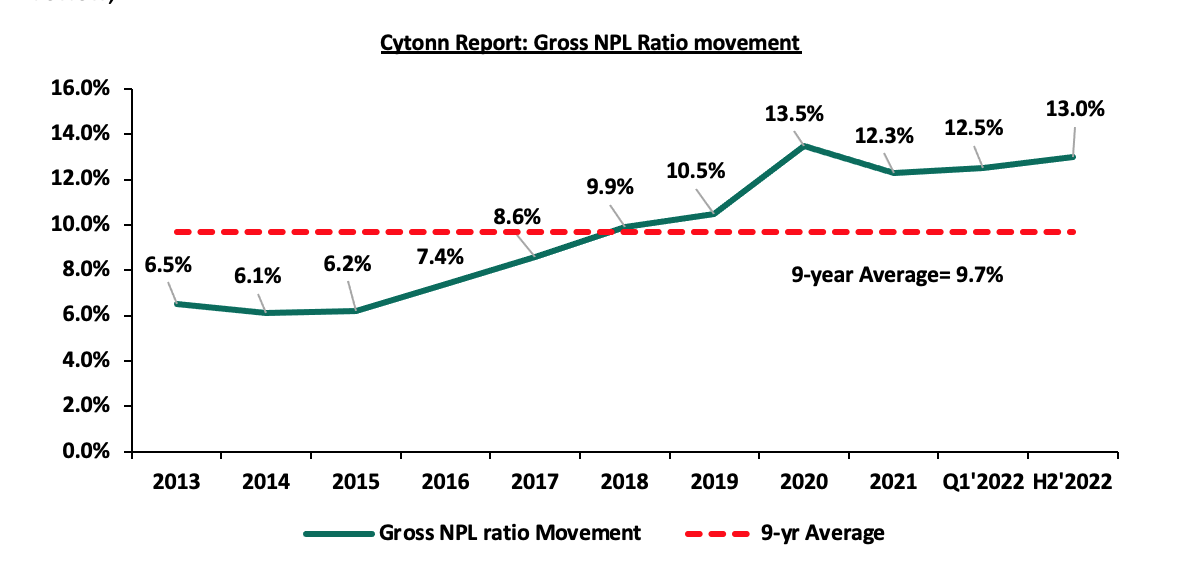
- High cost of credit – There are other associated overhead costs incurred during borrowing such as bank fees, legal fees and government levies, valuation fees and insurance that are borne by the borrower, in addition to the interest charged on loans. The overhead costs increase the cost of credit, hence limits demand for credit by the private sector,
- Elevated Inflation rate – High inflation levels act as disincentive in both consumption and investment rates due to increased prices of both food and factor inputs. As a result, both private consumers and companies cut on spending and production levels respectively when inflation rates hike. For instance, the rise in inflation rate to 9.6% in October 2022, driven by high food and fuel prices in the country has lowered the household consumption resulting in decline in sales volumes. This is evidenced by the decline in Purchasing Managers Index(PMI) to 50.2% in October 2022 from 51.7% in September 2022 depicting deterioration of the business environment. Business deterioration due to low sales volumes leads to reduced credit demand by the private sector,
- Lack of financial knowledge – Majority of private sector businesses such as small and medium enterprises (SMEs) require financial information to determine the optimal measures of minimizing their debts, in terms of acquiring loans with lower interest rates and flexible repayment options. Additionally, financial knowledge help private businesses make adequate comparisons on lending options to choose from,
- Over-reliance on the banking sector - The Kenyan private sector is over dependent on lending from commercial banks due to under development of alternative sources of funding such as leasing, venture capital funds, development finance institutions and bonds and equity markets. Key to note, according to the Capital Markets Authority, there has been no recent IPO listing in the Equities market with the last IPO issued by Stanlib Fahari IREIT in October 2015 having an undersubscription rate of 29.0%. Similarly, there are only four issued corporate bonds with a low bond turnover at Kshs 0.1 bn in Q3’2022 as compared to government bonds at Kshs 197.0 bn in the same period. The low issuance and turnover rates show the overreliance of credit demand on the banking sector,
- Political Risk – The private sector growth in Kenya is susceptible to political tensions attributable to uncertainties surrounding the business environment and deterioration of the business environment as witnesses in the August 2022 electioneering period where credit demand by the private sector declined by 1.6% to Kshs 79.6 bn in Q2’2022 from Kshs 124.1 bn recorded in Q1’2022.
Section IV: Initiatives placed to promote private sector credit growth
Based on the importance on private sector contribution to GDP, the Central Bank of Kenya (CBK), in collaboration with other stakeholders, has implemented various measures ranging from licensing of new products, technological innovations and public education to promote credit growth in Kenya. Some of the initiatives include;
- Implementation of the Credit Guarantee Scheme (CGS) Regulation 2020 to enhance credit access to MSMEs – Since its inception, the scheme has facilitated 2,609 business access loans to MSMEs totalling to Kshs 4.1 bn as at 31st August 2022 surpassing its seed capital of Kshs 3.0 bn. Key to note, 60.0% of the beneficiaries were small enterprises, while micro and medium enterprises accounted for 25.0% and 15.0% respectively,
- Alternative sources of borrowing - The Kenyan Government through the Central Bank of Kenya pursued alternative funding sources such as external borrowing. However, the government should focus more on the concessional borrowing such as soft loans that are cheaper as compared to commercial loans such as the Eurobonds. By implementing alternative borrowing, the government domestic credit from commercial banks will reduce, and as a result, increased the ease of credit access to the private sector. Additionally, the government has implemented Public-Private Partnerships (PPP) initiatives in different thematic Real Estate Sector sectors such as infrastructure and housing projects to reduce its borrowing costs and promote fiscal consolidation efforts. The move helps in minimizing the crowding out of the private sector,
- Lowering the cash reserve requirement ratio – The CBK reviewed the cash reserve ratio in March 2022 to 4.25% from the preceding 5.25% releasing Kshs 35.2 bn additional liquidity to commercial banks. The increased liquidity improved credit access within the economy, and consequently to the private sector,
- Adoption of the cost of credit website for commercial banks in enhancing loan comparison – The introduction of the credit cost website by the Kenya Bankers Association (KBA) in collaboration with the Central Bank of Kenya (CBK) has enabled commercial banks and microfinance institutions to publish their costs of credit. The initiative has promoted disclosure of bank charges and fees and ease comparison of loan rates to facilitate informed borrowing decisions by the private sector,
- Approval of banks risk-pricing models – The Central bank of Kenya has approved risk-pricing models for 22 out of the 38 commercial banks in a bid to increase credit accessibility based on a lenders borrowing history the customers while helping banks and other lenders to manage their risk exposure. The initiative will increase credit accessibility to the private sector based on an individual financial profile in terms of borrowing and repayment history,
- Capital Markets Authority (CMA) regulations on crowd funding - Recently, the Cabinet Secretary for the National Treasury and Planning, through the Capital Markets Authority (CMA) gazetted the amended Capital Markets (Investments-Based Crowdfunding) Regulations 2022, seeking to increase the access to funding for the Micro, Small and Medium Enterprises (MSMEs), start-ups and businesses while protecting investor’s interest by reducing the platform operator’s annual regulatory fee by 50.0% to Kshs 100,000.0 from Kshs 200,000.0.
- Credit facilities to target groups such as Youth and Women – The government under the Public Finance Management Regulations has rolled out various loans targeting women, youths and persons living with disabilities (PWDs) such as the Youth Development Fund, Uwezo Fund and Women Enterprise Fund in increasing credit to special groups people. Uwezo Fund has proven the most successful loan rollout fund due to its decentralized criterion of disbursements. The fund has extended cumulative loans amounting to Kshs 7.2 bn to 79,164 groups comprising of 70.0% female groups and 30.0% male groups since inception,
Additionally, the banking system has put in place measures to aid private sector credit growth such as;
- Deepening financial inclusion through digital integration – Banks are increasing their presence and accessibility to the private sector through digital avenues such as apps and USSD in promoting credit uptake. Banks such as KCB and NCBA partnered with Safaricom to offer the overdraft credit facility of Fuliza in increasing credit lending to SMEs. Additionally, KCB has the VOOMA app specifically targeting lending to small and medium enterprises,
- Restructuring of loans – Commercial banks collectively restructured loans amounting to KSh 1.7 tn involving 300,000 loan accounts between March 2020 and February 2021 in an effort to improve flexibility of credit repayment to the private sector and accelerate post COVID-19 businesses recovery,
- Adoption of risk-based pricing - 22 out of the 38 commercial banks have adopted risk-based pricing as a measure of tailoring loans to a customer’s financial profile while helping banks and other lenders to manage their risk exposure. The initiative will increase credit accessibility to the private sector based on an individual financial profile in terms of borrowing and repayment history,
Section V: Comparison against other countries
According to the World Bank, Kenya’s domestic credit extended to the private sector outperformed majority of the Sub-Saharan countries. The Kenya’s domestic credit extended to private sectors as a percentage of the GDP came in at 32.1%, 6.8% points lower than the average Sub-Saharan domestic credit to private sectors lending which stood at 38.9% in the same period. Although Kenya outperformed majority of Sub-Saharan countries in credit extended to the private sector, the country still underperformed against developed economies. The graph below shows domestic credit extended to the private sector over the years and a comparison of Kenya’s performance against selected economies;
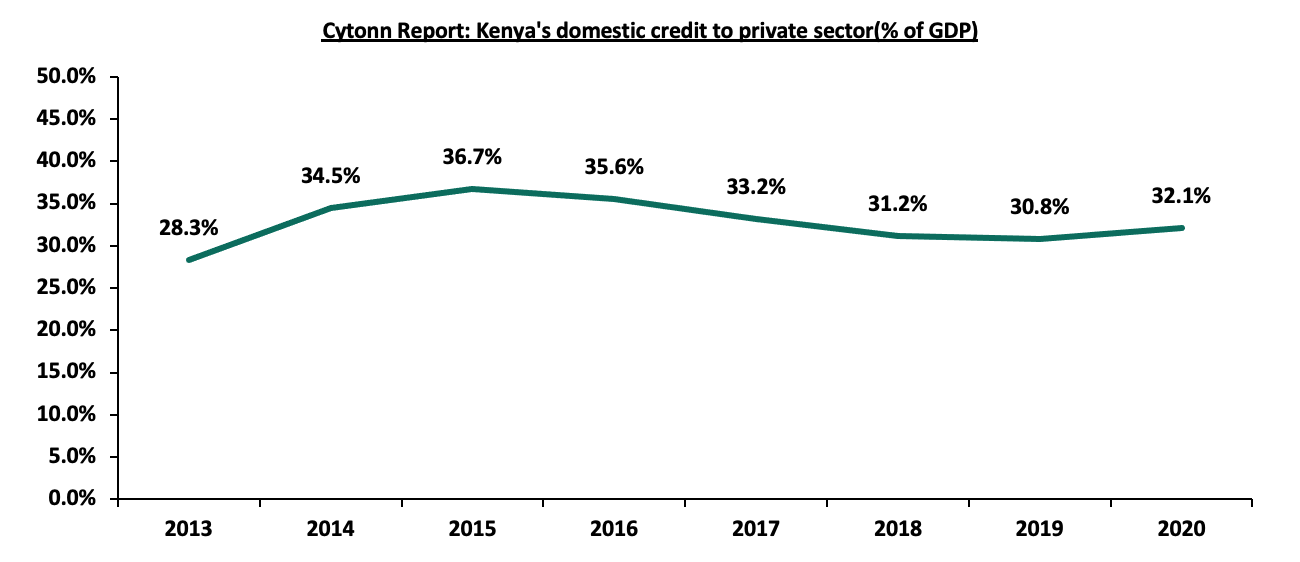
Source: World Bank

Source: World Bank
Different developed countries have adopted different measures in enhancing private sector credit growth. Some of the successful measures include:
- Project Finance Structuring – a financing option structured around a projects own operating cash flow and assets alleviating investments risks and raise finance at a low cost. China used the measure in 1997 to launch a local contract undertaken by Plantation Timber Products (Hubei) Ltd amounting to USD 57.0 mn greenfield project in installing modern medium-density fibreboard plants in interior China. Due to the limited-recourse financing nature of the project, IFC sourced for USD 26.0 mn in syndicated loans, at a time when foreign commercial banks remained cautious about project financing in China's interior provinces.
- Universal supervisory body to monitor fund disbursements – The UK has a universal monitoring organization, the British Business Bank (BBB), in charge of monitoring all fund operations of government fund initiatives such as Enterprise Finance Guarantee Scheme (EFGS), the British Growth Fund (BGF), the Funding for Lending Scheme (FLS) and the Start Up Loans Scheme (SLS). The measure helps in promoting accountability and transparency of funds disbursements.
Section VI: Conclusion and Recommendation
The private sector is a significant contributor to the Kenyan GDP. However, credit availability remains a major hindrance for the sector’s growth. To offset the downside, the government of Kenya needs to adopt or emulate the funding model used by the developed economies in creating an enabling environment for two or more players to compete within the Kenyan credit market. Currently, the credit market is dominated by commercial banks while the Capital markets and other sources only contribute 1.0% of funding to all businesses. Additionally, the government needs to adopt a consumer-centred approach for borrowing to encourage private sector credit demand. We believe that additional measures need to be implemented in order to promote the private sector credit growth. Below are some of the initiatives that the government can adopt;
- Enhance financial literacy to the public – The government needs to come up with ways of sensitizing the public on financial literacy in terms of debt management and budgetary skills, as well as, an understanding of the different financial instruments and credit within the Kenyan financial market. Financial literacy will enable the private sector to distinguish the available sources of credit in the markets and understand the terms and conditions of each credit option,
- Establish a regulatory framework to enhance consumer protection by enforcing consumer-centred financial laws, ensuring financial products are transparent and competitive, as well as handling of consumers complains and issues,
- Develop the capital markets to offer alternative sources of capital– The capital market in Kenya is under-developed as it contributes about 1.0% of total funding to businesses in Kenya. Deepening the capital markets framework will unlock a key financing avenue that businesses can tap into. Further, the government, in conjunction, with the financial sector regulators need to come up with a sound legal framework to promote transparency of the corporate bond market bonds, as well as investor education on key legislations that apply to the specific bond market,
- Enhancing oversight on fund initiatives to promote transparency - The government needs to come up with measures or an independent institution that will oversee the running of funds such as the Uwezo Fund and Youth Development Fund in terms of timely publication of updates on amounts disbursed, disclosure of beneficiaries already covered and requirement regulations. The strategy will help in building confidence with the public. This will also ensure that the proposed Hustler Fund does not lead to loss of taxpayer’s funds,
- Adoption of concessionary loans - Allow the banking sector to provide concessionary loans to small and medium enterprises with focus on the Agricultural sector as it is the leading contributor to the GDP and accounts for 70.0% of employment of the rural population,
- Enhance Fiscal consolidation – The high borrowing rate by the government is to finance its budget deficit, however, the government can bridge the deficit gap through expenditure reduction measures and prioritization of government projects limit capital expenditure to projects which the economic benefits outweighing costs. The strategy would reduce the need for high government borrowing and the crowding out of the private sector.
In conclusion, we are of the opinion that the initiatives already put in place by the government to promote access to credit by the private sector coupled with creating an enabling operating business environment for alternative credit sources will come in handy in promoting credit growth in the private sector. We expect sustained growth in the lending to the private sector on the back of the existing policies aimed at enhancing credit uptake which in turn will contribute to country’s economic growth. However, for the new administration to effectively promote private sector credit growth, the credit market must be streamlined for transparency and credibility in gaining investor confidence for a sector marred with corruption and misappropriation scandals from time and time again. Additionally, there is possibility of cautious lending by banks as a result of elevated credit risk perception driven by the high inflationary pressures, deterioration of the banking sector asset quality, as well as, interest rate hikes by banks on various loans.



